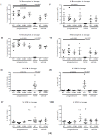mPR-Specific Actions Influence Maintenance of the Blood-Brain Barrier (BBB)
- PMID: 36077089
- PMCID: PMC9456378
- DOI: 10.3390/ijms23179684
mPR-Specific Actions Influence Maintenance of the Blood-Brain Barrier (BBB)
Abstract
Cerebral cavernous malformations (CCMs) are characterized by abnormally dilated intracranial microvascular sinusoids that result in increased susceptibility to hemorrhagic stroke. It has been demonstrated that three CCM proteins (CCM1, CCM2, and CCM3) form the CCM signaling complex (CSC) to mediate angiogenic signaling. Disruption of the CSC will result in hemorrhagic CCMs, a consequence of compromised blood-brain barrier (BBB) integrity. Due to their characteristically incomplete penetrance, the majority of CCM mutation carriers (presumed CCM patients) are largely asymptomatic, but when symptoms occur, the disease has typically reached a clinical stage of focal hemorrhage with irreversible brain damage. We recently reported that the CSC couples both classic (nuclear; nPRs) and nonclassic (membrane; mPRs) progesterone (PRG)-receptors-mediated signaling within the CSC-mPRs-PRG (CmP) signaling network in nPR(-) breast cancer cells. In this report, we demonstrate that depletion of any of the three CCM genes or treatment with mPR-specific PRG actions (PRG/mifepristone) results in the disruption of the CmP signaling network, leading to increased permeability in the nPR(-) endothelial cells (ECs) monolayer in vitro. Finally, utilizing our in vivo hemizygous Ccm mutant mice models, we demonstrate that depletion of any of the three CCM genes, in combination with mPR-specific PRG actions, is also capable of leading to defective homeostasis of PRG in vivo and subsequent BBB disruption, allowing us to identify a specific panel of etiological blood biomarkers associated with BBB disruption. To our knowledge, this is the first report detailing the etiology to predict the occurrence of a disrupted BBB, an indication of early hemorrhagic events.
Keywords: CCM signaling complex (CSC); CSC-mPRs-PRG (CmP) signaling network; biomarkers; blood–brain barrier (BBB); cerebral cavernous malformations (CCMs); classic nuclear progesterone receptors (nPRs); endothelial cells (ECs); nonclassic membrane progesterone receptors (mPRs).
Conflict of interest statement
The authors declare no conflict of interest.
Figures












Similar articles
-
CmPn/CmP Signaling Networks in the Maintenance of the Blood Vessel Barrier.J Pers Med. 2023 Apr 28;13(5):751. doi: 10.3390/jpm13050751. J Pers Med. 2023. PMID: 37240921 Free PMC article. Review.
-
Whole-Genome Omics Elucidates the Role of CCM1 and Progesterone in Cerebral Cavernous Malformations within CmPn Networks.Diagnostics (Basel). 2024 Aug 28;14(17):1895. doi: 10.3390/diagnostics14171895. Diagnostics (Basel). 2024. PMID: 39272679 Free PMC article.
-
CCM signaling complex (CSC) couples both classic and non-classic Progesterone receptor signaling.Cell Commun Signal. 2022 Aug 15;20(1):120. doi: 10.1186/s12964-022-00926-z. Cell Commun Signal. 2022. PMID: 35971177 Free PMC article.
-
CmP signaling network unveils novel biomarkers for triple negative breast cancer in African American women.Cancer Biomark. 2022;34(4):607-636. doi: 10.3233/CBM-210351. Cancer Biomark. 2022. PMID: 35431232
-
Biomarkers derived from CmP signal network in triple negative breast cancers.Transl Breast Cancer Res. 2023 Jul 30;4:21. doi: 10.21037/tbcr-23-30. eCollection 2023. Transl Breast Cancer Res. 2023. PMID: 38751477 Free PMC article. Review.
Cited by
-
CmPn/CmP Signaling Networks in the Maintenance of the Blood Vessel Barrier.J Pers Med. 2023 Apr 28;13(5):751. doi: 10.3390/jpm13050751. J Pers Med. 2023. PMID: 37240921 Free PMC article. Review.
-
Familial CCM Genes Might Not Be Main Drivers for Pathogenesis of Sporadic CCMs-Genetic Similarity between Cancers and Vascular Malformations.J Pers Med. 2023 Apr 17;13(4):673. doi: 10.3390/jpm13040673. J Pers Med. 2023. PMID: 37109059 Free PMC article. Review.
-
Whole-Genome Omics Elucidates the Role of CCM1 and Progesterone in Cerebral Cavernous Malformations within CmPn Networks.Diagnostics (Basel). 2024 Aug 28;14(17):1895. doi: 10.3390/diagnostics14171895. Diagnostics (Basel). 2024. PMID: 39272679 Free PMC article.
-
Membrane Progesterone Receptors (mPRs/PAQRs) Are Going beyond Its Initial Definitions.Membranes (Basel). 2023 Feb 22;13(3):260. doi: 10.3390/membranes13030260. Membranes (Basel). 2023. PMID: 36984647 Free PMC article. Review.
-
Key Members of the CmPn as Biomarkers Distinguish Histological and Immune Subtypes of Hepatic Cancers.Diagnostics (Basel). 2023 Mar 7;13(6):1012. doi: 10.3390/diagnostics13061012. Diagnostics (Basel). 2023. PMID: 36980321 Free PMC article.
References
-
- Abou-Fadel J., Jiang X., Padarti A., Goswami D., Smith M., Grajeda B., Walker W., Zhang J. CCM signaling complex (CSC) is a master regulator governing homeostasis of progestins and their mediated signaling cascades. bioRxiv. 2020 doi: 10.1101/2020.06.10.145003. - DOI
MeSH terms
Substances
LinkOut - more resources
Full Text Sources
Other Literature Sources

